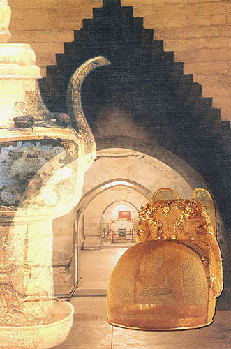Mausoleum of Emperor Shenzong, named Zhu Yijun (reign 1573-1620), the 13th emperor of the Ming Dynasty (1368-1644), and his two queens Xiaoduan, Xiaojing
Location:Beijing
Period: 1586-1590
Excavated from 1956 to 1958
Significance: It has supplied important material objects to the study of the history of Ming Dynasty.
 Introduction
Introduction
In November 2000, the Royal Mausoleum of Ming and Qing Dynasties was honored as "World Cultural Heritage" by the UN Organization of Science, Education and Culture. Located in northernChina, the Royal Mausoleum of Ming and Qing Dynasties is the biggest and most complete among the extant mausoleums inChinafor emperors and empresses built in ancient times.
|

|
| Gold wine dropper inlaid with jade dragon and gem: wine vessel (left, height 21.8 cm); Gold hat: used for procession (right, height 24 cm) |
Ming Mausoleum is built in a small basin at the foot ofTianshouMountainin Changping district, the northwest area ofBeijing, and 44km away from the downtown. The mausoleum consists of 13 tombs of the Ming Dynasty, generally known as "Ming Thirteen Mausoleum". Here is where 13 emperors and 23 empress of the Ming Dynasty were buried, together with many imperial concubines, princes, princesses, and many maids of the honor.
Ding Mausoleum is the representative of the royal tombs and also the only one whose underground palace was unearthed. The construction of Ding Mausoleum started in the 12th year of Wenli of Shenzong's reign (1584) and was completed in the 18th year of Wanli (1590). Buildings on the ground consist of Treasure City, Grand Mansion, Ling'en Hall, two ground auxiliary halls, Ling'en Gate, Ling Gate, Shenbo Oven, Dinvine Wardrobe, Divine Stock, Slaughter Pavilion and Wailuo City, etc. TheTreasureCityandGrandMansionof the Dingling have been preserved fairly well.
TheGrandMansionis not only gallant and splendid, but also does not have a piece of wood and a nail. The rafters, brackets and inscribed board of the upper and lower caves are all inlaid with white stone sculptures and painted with colorful pictures which look like wood structure.
TheUndergroundPalaceis a labyrinth palace building. The building consists of 5 underground halls, i.e. front, middle, back, left and right halls, with the total area 1,195 square kilometers. There are seven stone gates in the five halls. The stone gates of the front, middle and back halls were most finely done with sculptured white marble. Every stone gate has two leaves, each of which is 3.3 m high and 1.8 m broad and weighs about 4 tons. On every facade of leaf, 81 nipple-like nails and decorative beast-head holding knocker in the mouth are sculptured. The back hall, the biggest one in the underground palace, is also called labyrinth room, which is the main part of theUndergroundPalace. It is 9.5 m high, 9.1 m broad and 30.1 m long, paved with polished piebald stones. On the front of the coffin platform, inner and outer coffins are laid with the Emperor Zhuyijun in the middle and twoQueens, Xiaoduan and Xiaojing on two sides respectively.
 Cultural Heritage
Cultural Heritage
Exhibition Room: The excavated articles of Ding Ling are 3,000 odd in total, which include a great number of gold, silver, jade,Chinawares, silk, textiles, crowns, belts and ornaments of the emperor and queens, and tin wares, etc.
Gold Crown: It was made of extremely thin gold threads, on which two dragons playing with pearl were inlaid, a skilful masterpiece with vivid posture. It is the first discovery among excavated articles inChina.
PhoenixCrowns: Four Phoenix Crowns were excavated, on each of which 5,000 odd pearls and 1,000 odd precious stones were inlaid. Phenix Crown was worn by queens on ceremonial occasions.
Dragon Gown: It was worn by Emperor Zhuyijun on grand ceremonial occasions, on which 12 dragon designs were embroidered.
Hundred Son Clothes were worn by Queen Xiaojing, on which double dragon longevity character was embroidered. All around the clothes, designs of pine, bamboo, plum, stone, peach, pear, banana, glossy and different flowers and grasses and picture of hundred sons were embroidered, vivid and lively, remarkably true to life.
